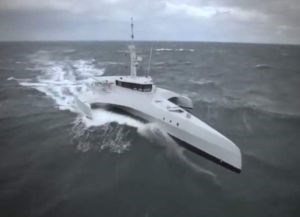Infused trimaran takes to the seas
French shipyard CMN has released a video showing the Ocean Eagle 43 infused epoxy trimaran in action.

CW featured the Ocean Eagle 43 in the Jan 2015 Inside Manufacturing article, "Dark knights: Sleek trimarans surveil the seas". The vessel's composite construction was completed by Chantier Naval H2X (La Ciotat, France) for shipbuilder CMN (Paris and Cherbourg, France). CMN has now released a video of the patrol vessel operating in Sea State 5 conditions, which on the 0-9 scale is defined as "Rough" with waves ranging from 2.5 to 4m in height.
One commentator on the video, who seems to know all of the details about this sea trial, notes that the Ocean Eagle 43 can sail 238 nautical miles at 15 knots with only 1 metric tonne of fuel, touted as very economical vs. monohull patrol boats which consume 4 to 5 times more fuel at the same speed. The commentator added that a similar-sized monohull in such a short wavelength state 5 sea would be jumping significantly at 28 knots and would likely have to reduce speed. The stability of the trimaran in zig zag maneuvers is also highlighted. The boat's lightweight composite construction helps in all of these performance areas.
Then heralded as the largest hull infused with epoxy resin in a single shot, the trimaran's 43-meter structure benefitted from extensive material development assistance from resin supplier Sicomin (Chateauneuf les Martigues, France) which provides additional project details on its website.
Related Content
-
Large-format 3D printing enables toolless, rapid production for AUVs
Dive Technologies started by 3D printing prototypes of its composite autonomous underwater vehicles, but AM became the solution for customizable, toolless production.
-
Plant tour: Albany Engineered Composites, Rochester, N.H., U.S.
Efficient, high-quality, well-controlled composites manufacturing at volume is the mantra for this 3D weaving specialist.
-
Jeep all-composite roof receivers achieve steel performance at low mass
Ultrashort carbon fiber/PPA replaces steel on rooftop brackets to hold Jeep soft tops, hardtops.











.jpg;maxWidth=300;quality=90)

